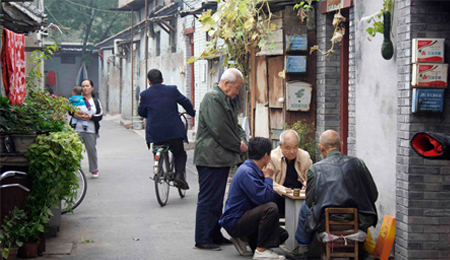

Comprised of narrow grey-bricked alleyways, one-story houses with curved tile roofs, and traditional courtyards called Siheyuan(四合院), Hutongs(胡同) have been recognized as one of the most treasured types of vernacular housing in China, documenting the cultural and historical transformation in Beijing ever since the Yuan Dynasty (1271 – 1368).
As China pursued cultural reform and opening-up policy in the 1980s and 1990s, street-facing exterior walls of Hutongs had been converted into storefronts to support a booming economy by hosting numerous private businesses like cafes, restaurants, bars, and featured shops, many of which later became the city’s most dynamic food and beverage establishments.
Nevertheless, with the rush of “development” driven not only by the government-issued mandate but also by the high market value of urban land, 90% of the original 7000-8000 hutong neighborhoods had either been leveled to make room for towering residential complexes or had their businesses bricked up and lost its own identity. Even when some Hutongs did survive, they were transformed into tourist attractions, where the structures are preserved, but the cultural spirits are long lost. In the meantime, the remaining neighborhoods are also taken over by wealthy Chinese and foreigners, made possible with gentrification, to replace local tenants who sometimes sell willingly and sometimes are forced out.
Solely opting for the modernization of cities brings sure losses onto community building and the preservation of cultural heritage
Human beings are born to engage with others in spontaneous and organic ways, a concept that had served for centuries as the building block for urban living quarters. A modern community built entirely of sky-scrapers – even when composed of traditional structures – and digital zoom hangouts may seem to prioritize traditional principles of organic human relations, but the remains of exterior structures alone don’t preserve the cultural spirits that help bond communities together. After all, the significance of cultural spaces is so much more than the actual architectures: they are a living imprint of history. They are about people and generations of traditions. Well-integrated modern designs complement spontaneous connections in the public sphere but do not replace them. Our relationship with the past and our appreciation for culture determine how we can move forward as a community. Preferring modernity over culture is a fundamental error of the same degree as believing that if you have cars, you won’t need legs anymore.
The bottom line…
here is that urban modernization should not clash with the preservation of traditions and cultural heritage. The very definition of modernity ought to center around choices and freedom. Current urban modernization efforts however strictly define the expectations for our public selves. For a city to be modern in the true sense, it should be a space that allows an infinite variety of human talents and interests to build competing yet inclusive environments, where members of a community realize their contrasting self-interests and learn to work together.